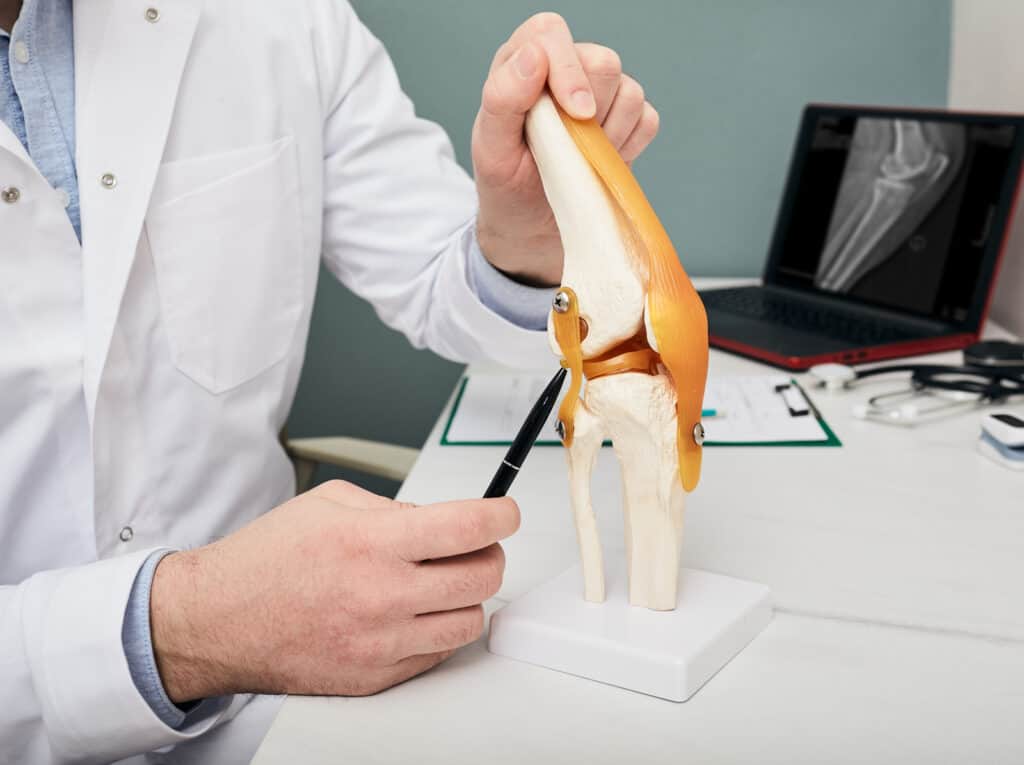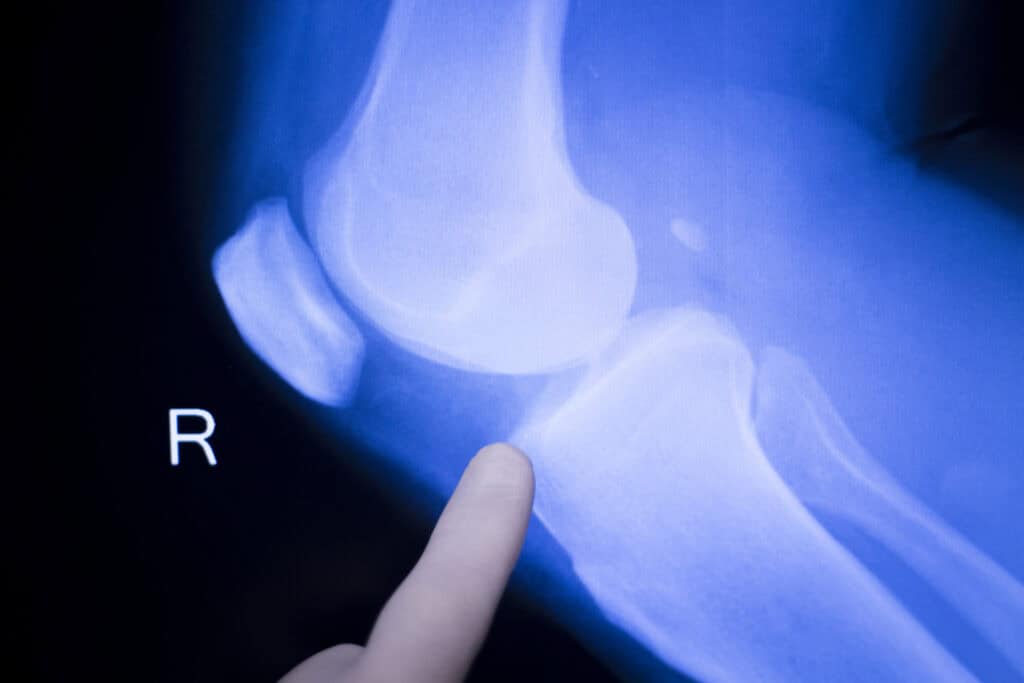The meniscus is a C-shaped piece of cartilage in the knee that cushions and stabilizes the joint. Each knee has two menisci—one on the inner (medial) side and one on the outer (lateral) side. These structures act as shock absorbers, distributing weight evenly and preventing excessive wear on your bones.
A meniscus tear is a common knee injury that occurs when this cartilage is damaged, often due to sudden twisting, forceful rotation, or gradual degeneration. Athletes, especially those in sports requiring quick pivots or abrupt stops, are at higher risk. However, age-related wear and tear can also weaken the meniscus, making it more vulnerable.
This injury can lead to stiffness, swelling, and mobility issues, affecting daily activities like walking, climbing stairs, or engaging in sports. Without proper care, a torn meniscus can worsen, causing chronic joint instability and discomfort. In this article, we’ll discuss these tears in more depth and treatment options.
What Causes a Meniscus Tear?

Meniscal tears result from sudden movements, repetitive stress, or gradual cartilage degeneration. Acute injuries are common in sports that require quick pivots, deep squats, or sudden stops, such as basketball, soccer, and football. A forceful impact, like a tackle or a fall, can also cause a tear.
Overuse injuries develop over time, especially in physically demanding professions or activities that involve frequent kneeling or lifting. As you age, your cartilage loses elasticity, increasing the risk of tearing even from routine movements.
Some meniscal injuries occur without a specific incident, developing due to progressive joint wear. Early recognition and proper management can help prevent further knee complications and long-term discomfort.
Meniscus Tear Symptoms
The severity of meniscus tear symptoms varies based on the location and extent of the injury. Common signs include:
- Joint stiffness and swelling that develops over several hours or days
- Pain when twisting, squatting, or bending the knee
- A clicking, popping, or locking sensation in the joint
- Reduced range of motion, making it difficult to fully extend or flex the knee
- A feeling of the knee giving out or lacking stability
While some people can walk with minor tears, others experience significant discomfort and restricted movement. Symptoms can gradually worsen if left untreated, potentially leading to chronic joint damage. Seeking medical evaluation early can help you prevent long-term complications.
How Is a Meniscus Tear Diagnosed?

Doctors diagnose a meniscus tear using a physical examination and specialized tests like the McMurray test, which involves rotating the knee to detect pain or clicking. Imaging, such as an MRI, provides a detailed view of soft tissue damage, while an X-ray can rule out fractures or arthritis.
Treatment Options for Meniscus Tears
Meniscus tear treatments depend on the severity of the tear. Non-surgical approaches–including rest, ice, compression, and elevation (RICE), physical therapy, and anti-inflammatory medications–help many patients recover. Bracing may also be recommended for additional support. Some patients also explore regenerative options like platelet-rich plasma therapy, which uses concentrated growth factors to promote healing in the knee joint.
Let’s explore some of these options.
1. Conservative Management
For mild to moderate tears, non-surgical treatments can relieve symptoms and promote healing. The RICE method—rest, ice, compression, and elevation—helps manage inflammation, while bracing stabilizes joints. Anti-inflammatory medications like ibuprofen or naproxen may help ease discomfort. If inflammation persists, a doctor may recommend a corticosteroid injection to reduce swelling and pain.
2. Physical Therapy
A structured physical therapy program is essential for restoring joint mobility and strength after a meniscus injury. Exercises focus on reinforcing the quadriceps, hamstrings, and stabilizing muscles to support the knee. Therapists also incorporate stretching, balance training, and controlled movement exercises to improve flexibility and reduce stiffness. A consistent rehab plan can accelerate healing and, in some cases, help patients avoid surgery.
3. Surgical Intervention
For severe cases or when conservative treatments fail, arthroscopic surgery may be required. The two primary procedures include:
- Meniscus repair – The torn cartilage is sutured to heal naturally, best for younger patients or well-vascularized tears.
- Partial meniscectomy – The damaged portion of the meniscus is removed to relieve pain management and restore mobility.
Both procedures are minimally invasive, allowing for quicker recovery with post-surgical physical therapy playing a critical role in regaining knee strength and flexibility.
How to Prevent a Meniscus Tear

Preventing a meniscus tear starts with protecting and strengthening the knee joint. Warming up with dynamic stretches and light movement before activity prepares the muscles and reduces strain. Strengthening the quadriceps, hamstrings, and core enhances joint stability, lowering the risk of sudden twists or excessive force.
Maintaining a healthy weight reduces unnecessary joint stress, while wearing supportive footwear improves balance and absorbs shock. Additionally, avoiding sudden directional changes and using proper movement techniques can further protect the knee.
By practicing these strategies, you may be able to reduce injury risk and keep your knees strong and mobile.
Frequently Asked Questions

How Long Does It Take to Recover From a Meniscus Tear?
Recovery depends on the severity of the tear and treatment approach. Mild tears typically heal in four to six weeks with rest and physical therapy, while surgical recovery can take three to six months. Following a structured rehab plan, including strength exercises and activity modifications, is key to a full recovery.
Can a Meniscus Tear Heal Without Surgery?
Some small tears, especially those in well-vascularized areas, may heal with rest, bracing, and physical therapy. However, larger or complex tears often require surgery to restore knee function. A specialist can determine which torn meniscus treatment option is right for you.
What Exercises Are Safe During Recovery?
Low-impact exercises like straight-leg raises, quad sets, and seated knee extensions help maintain strength while protecting the meniscus. High-impact activities such as running, jumping, and deep squats should be avoided until cleared by your healthcare provider. A guided rehab plan ensures a safe return to activity.
What Happens If a Meniscus Tear Is Left Untreated?
Ignoring a meniscus tear can lead to persistent pain, swelling, and knee instability. Over time, untreated tears may worsen, increasing the risk of cartilage damage and early-onset arthritis. Seeking treatment early can help prevent long-term joint problems.
Schedule Your Consultation Today for Relief

Professional care can make all the difference if you're experiencing persistent knee pain or meniscus tear symptoms. At Northeast Spine and Sports Medicine, our specialists provide comprehensive diagnosis and treatment, including physical therapy, pain management, and surgical options when necessary.
Delaying treatment can lead to worsening discomfort and long-term joint damage, so don’t wait to get the care you need. Schedule a consultation today by calling (848) 360-4667 or booking an appointment online. Take the first step toward pain-free movement!


